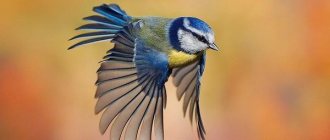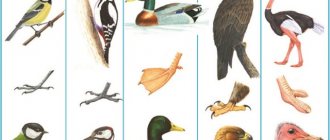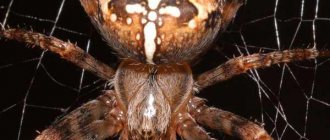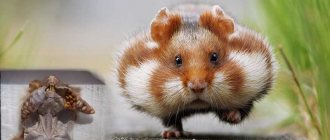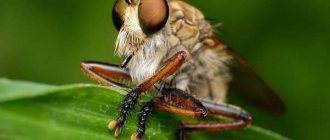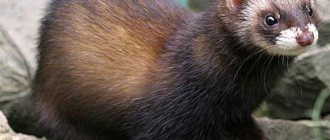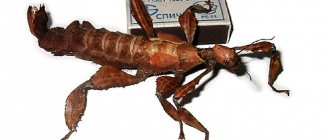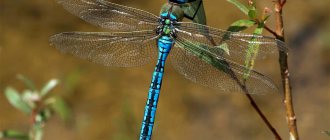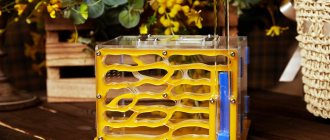Structure
However, despite the variety of forms, a common distinguishing feature of this group is the presence of three pairs of legs on the thoracic segments. Hence the second name of the superclass - Hexapoda, that is, “six-legged”.
External structure using the example of an adult antlion: 1 - head 2 - chest 3 - abdomen 4 - eyes 5 - antennae 6 - hypostigma 7 - pterostigma
On top, the body of insects is usually covered with a chitinous shell, the cuticle, which in these animals serves as an external skeleton. As a rule, an adult insect (imago) has a body consisting of a head, thorax and an eleven-segmented abdomen. Six legs are attached to the thoracic region, and winged insects also have wings.
Head structure
Insects breathe using the trachea system or the entire surface of the body.
Nervous system
The nervous system consists of a series of nerve ganglia, or ganglia, from which nerves arise. In higher insects, the number of ganglia decreases due to their combination to 2–3 or even one, which is associated with their complex behavior.
The digestive system of insects is also characterized by a number of common features. Its basis is the digestive canal, morphologically (in structure) it consists of the foregut, middle and hindgut. Depending on the food consumed and the method of digestion, the length of the digestive tract and the development of its individual parts differ in different insects.
Ancient primitive (wingless) insects appeared 350-400 million years ago during the Devonian period. Winged - 280-350 million years ago. Insects are very diverse creatures. They differ not only in appearance, but also in their biology, individual development, types of transformation, means of adaptation to the environment, and care for their offspring.
Digestive system of insects
Class Insects (Insecta). Types of mouthparts: gnawing type (grasshopper), sucking type (butterfly) and licking type (fly)
The nature of their diet is varied (predators, parasites, herbivores, etc.). The structure of the oral apparatus is associated with the type of food and lifestyle. There are several types of mouthparts.
The gnawing mouthparts are considered the most ancient (characteristic of primitive insects) and are common in insects that feed on solid plant or animal food (beetles, cockroaches, orthoptera, etc.). On top, the oral opening of such an apparatus is covered by an unpaired plate (upper lip), on the sides there are paired upper and lower jaws, and on the bottom – an unpaired lower lip. The upper lip is formed by a fold of the cuticle. The upper jaws are represented by plates with teeth on the inside. The lower jaws consist of two segments. On the upper segment there is a pair of ruminant lobes and a mandibular dissected palp (the organ of touch and taste). The lower lip was formed by the fusion of the lower jaws, consists of two segments and has a pair of lower labial palps and two pairs of ruminant lobes.
The piercing-sucking apparatus is characteristic of insects (bugs, mosquitoes, etc.) that feed on liquid food: plant juice, tissue, animal blood.
A sucking mouthpart in the form of a long tube of two halves is found in butterflies that feed on the juice of fruits and the nectar of flowers. Flies have a peculiar oral apparatus with a fleshy lower lip - licking (modified sucking).
Gnawing-licking mouthparts are found in Hymenoptera (bees, wasps, etc.). These are mouthparts that have extended into a proboscis to suck up nectar. At the same time, the upper jaws remained almost unchanged (reduced ruminant teeth) and are used for the structure of cells. Sometimes adult insects do not feed (mulberry moths), their oral organs do not function and may be reduced.
The digestive system consists of the oral cavity, pharynx, esophagus, large crop, muscular stomach (in insects that feed on solid food, the walls are thick with chitinous teeth or plates for grinding food), midgut, hindgut, which ends in the anus.
The ducts of the salivary glands open into the oral cavity. Their secretion moistens and partially dissolves solid food. In bees, the secretion of the salivary glands turns into honey when mixed with nectar. In the caterpillars of butterflies, hymenoptera larvae and some other insects, the salivary glands are modified into silk-secreting or spinning glands. Silk thread is used to build a cocoon, protective formations, etc.
Worker bees feed the larvae of the future queen with the secretion of the pharyngeal glands.
The inside of the midgut is lined with glandular epithelium, which secretes digestive juice. Insects do not have a liver. Some insects, like spiders, are capable of extraintestinal digestion (ladybug larvae, diving beetles, etc.).
Development
Insects begin their life with eggs, the appearance and shape of which are very diverse. Eggs are also laid in different ways: one at a time, in groups, openly, immersed in the substrate or covered in various ways. The variety of egg shapes and means of laying them even makes it possible to identify certain groups of insects with precision down to genus and species. The embryonic development of insects occurs in the egg, resulting in the formation of a larva. The larva emerges from the egg shell in one way or another. She eats and grows, but only grows when she molts.
Incomplete development: locusts
The transformation of a larva into an adult is called metamorphosis. There are two main types of development - incomplete and complete. When metamorphosis is incomplete, the eggs hatch into larvae that look like smaller copies of adults. The only difference is that they do not have a reproductive system and only the rudiments of wings. During molts, they grow and, bypassing the pupal stage, turn into adults. With complete metamorphosis, the larva first turns into a pupa, and only then into an adult. There are three main types of pupae:
- open or free
- covered, covered with a hard shell
- hidden, covered with hardened, not shed skin, which acts as a false cocoon.
Before turning into a pupa, the larva can form a cocoon of silk, like silkworms; The pupae of daytime butterflies are often not covered with anything. Other insects, on the eve of pupation, look for some kind of shelter: cracks under the bark, rolled up leaves, or bury themselves in the ground. Many insects have immobile pupae. Mosquito pupae swim well, and lacewing pupae crawl. Under the shell of the pupa, complex transformations occur, as a result of which the organs of the imago are formed.
Are insects animals or not?
These are ancient animals that make up one of the largest classes of the animal kingdom. Numerous species of insects live in nature. Some have wings, while others, in the process of evolution, have lost the ability to fly. Some are only a few mm in size, while others can reach 10 cm.
Insect species are grouped by the number of limbs, antennae, wings, structure of the respiratory system, eyes and body parts.
Number
There are many species of these creatures, their total number is estimated at 940 thousand, but some researchers give a higher figure - 1.5 million. It is not possible to find out the real number. So what are insects?
Dimensions
The largest is the stick insect Phobaeticus chani, its length is 35.7 cm, and if the limbs are extended, then 56.7 cm.
The smallest are considered to be the males of the parasitic riders Dicopomorpha echmepterygis. Their dimensions barely reach 0.138mm.
Reproduction
Full Development: Stag Beetle
Reproduction in most insects is accompanied by mating and fertilization and is associated with the participation of two sexes. However, insects also have other methods of reproduction:
- viviparity - the eggs mature in the female’s body, and the larvae immediately emerge (for example, in Madagascar and a number of other cockroaches). To the observer, it looks as if the insect is “giving birth,” but this process is completely different from gestation in humans and higher mammals.
- parthenogenesis - reproduction without the participation of a male, when the female lays unfertilized eggs, and larvae emerge from them. It is very common among stick insects, but is also found in many other groups - in cockroaches, mantises, and all social insects (in bees, wasps, ants, and bumblebees, working individuals appear precisely from unfertilized eggs).
- pedogenesis is a special case of parthenogenesis, the ability to reproduce at the larval stage. Found in fanwings, micromalthus beetles, gall midges and bagworms.
- polyembryony - the development of several embryos from one zygote. Interestingly, in addition to insects, it is also observed in armadillos and bryozoans.
Sense Organs of Insects
On the head there is 1 pair of antennae (organs of smell and touch). Various structure of the antennae: comb-shaped, club-shaped, filamentous, lamellar, bristle-shaped, serrated, etc. The organ of vision is complex (compounded) eyes, sometimes there are simple ones (1 – 3). Each compound eye consists of a large number of facets (several thousand). Most insects do not perceive red color, but they perceive ultraviolet radiation well. Simple eyes (not capable of perceiving images) react to the degree of illumination and can perceive polarized light. Insect larvae with complete metamorphosis have lateral eyes (from one to several pairs). Each such eye can perceive images of objects. The body and limbs are covered with hairs and scales, which are receptors for taste, touch, etc. Some insects have a hearing organ (in grasshoppers, on the front pair of legs, etc.).
Dimorphism
A male (left) and female rhinoceros beetle (Oryctes nasicornis) exhibit sexual dimorphism: the male has a horn, the female does not
In adult insects, sexual dimorphism and, in some cases, polymorphism are often observed. The most common type of polymorphism is sexual, inherent in social insects (bees, ants, wasps, termites). Another type of polymorphism can be called environmental, since it occurs under the influence of the external environment (for example, the presence and amount of available food). An example of ecological polymorphism is seasonal polymorphism: generations of the same species that appear in different months differ from each other. For example, in the moth butterfly (similar to the urticaria and belongs to the same family of nymphalids), the spring and summer generations differ in both color and size.
Different in socialization
All insects are conventionally divided into two categories: solitary and social. According to the names, they either live on their own and interact only in the case of reproduction, or they exist in a colony, family, or clusters.
Social insects
This includes those who live in an organized family and their own hierarchy. These species have a structure and their own occupation for each family member.
Paper wasps. This species has a nest that is built by workers, a queen that is responsible for reproduction, and animals that feed the offspring.
Termites. They build homes and live in colonies, feed on wood and pose no danger other than possible destruction.
Solitary insects
Those that do not live in colonies or families. They prefer to live alone and not meet others like themselves unless necessary.
Earwigs
After mating, the mother carefully arranges a place of residence and remains there until the babies are able to set out on an independent life. They don't touch anymore.
Scorpion
This arachnid is a prime example of loners. They only meet other representatives of the species when mating is necessary. And even then, the male may suffer.
Insects with incomplete metamorphosis
Primary wingless
Let's consider insects with incomplete metamorphosis. These are, first of all, the most ancient and primitive primary wingless creatures, whose ancestors never had wings. These insects are represented by 4 orders:
Double-tailed Earwig, not to be confused with the Earwig
- bessyazhkovye, or protura (Protura),
- springtails, or springtails (Collembola),
- two-tailed or forktails (Diplura)
- Bristletails (Thysanura).
Springtails are interesting because they are widespread throughout the Earth and penetrate further than other insects into the Arctic and highlands. Some species even live in Antarctica!
Cockroaches
Madagascar cockroaches. By the way, this is also an example of sexual dimorphism
Insects from the superorder cockroaches (cockroaches, termites, mantises) are not similar in lifestyle and appearance, but have common ancestors who lived approximately 350 million years ago. The most ancient and primitive of them are cockroaches (Blattoptera). Of the more than 4.5 thousand species of cockroaches, only a few species are annoying companions to humans, while others live in the wild in a variety of places.
Termites and praying mantises are specialized groups. Termites (Isoptera) are social insects with pronounced polymorphism. In their behavior and way of life, they are closer to bees and ants, but differ significantly from them morphologically. With their strong jaws, termites are able to grind anything, causing great harm in their habitats. The large, elongated body of praying mantises (Mantodea) has a characteristic posture, hence their name. However, the appearance of praying mantises is deceptive. They are terrifying predators that mercilessly kill their prey with their strong jaws.
Some representatives:
- Marble cockroach
- Turkmen cockroach
- Argentine cockroach
- Death's head cockroach
Stick insects
The Australian stick insect feeds on eucalyptus and its eggs develop in anthills
Representatives of the order of ghost or stick insects (Phasmatodea) are also interesting. Stick insects live mainly in the tropics, with the exception of 7 species found in Transcaucasia, Central Asia and Southern Primorye. These amazing creatures are called ghostly creatures because they have the most varied body shapes (sticks, leaves, etc.), thanks to which they are completely invisible in their habitats. Stick insects reproduce mainly by parthenogenesis.
Orthoptera
The order Orthoptera includes: grasshoppers, grasshoppers, crickets, mole crickets and locusts. The order includes more than 20 thousand species - 24,481 species as of 2013, including 651 fossil species. Extinct representatives have been known since the Carboniferous period. Orthoptera are distinguished by strong legs adapted for jumping. Another feature of them is the presence in males of special organs that produce sounds - creaking or chirping, as well as the presence of hearing organs, which are also located on the legs.
Some representatives of the squad:
- House cricket
- Two-spotted cricket
- banana cricket
- Migratory locust
- Italian Prussian
- Moroccan locust
- Blue-winged filly
Bedbugs
Larvae of the bug Leptoglossus clypealis, feeding on pistachio trees
In the suborder of bedbugs (Heteroptera) we encounter parasites of animals and humans, plant pests, free-living and secondary aquatic (returned to water) forms. Bedbugs are ancient insects known since the Carboniferous period. Nowadays, there are about 40 thousand species of bedbugs. They are also called hemipterans, because the front part of the elytra of bedbugs is chitinous, and the back part is soft membranous. All bugs of temperate latitudes emit a pungent odor, while tropical ones, on the contrary, emit an aroma reminiscent of the aroma of daffodils or hyacinths. It is believed that this is a means of intimidation. Blood-sucking bugs live in burrows and nests and can be carriers of pathogens of a number of infectious diseases. The fight against them is complicated by their ability to undergo long-term (up to six months) fasting.
Homoptera
The suborder Homoptera includes various cicadas, grass flea beetles, aphids, scale insects and scale insects. Aphids and grass flea beetles are serious plant pests. Among the cicadas we find one of the longest-living insects. This is an American periodical cicada, the larvae of which develop for 17 years.
Lantern Pyrops candelaria
Mosaic of the planet
Where do insects live? The distribution of insects is very uneven, so in a nutshell you cannot tell about all the habitats of insects. There are habitats that are quite unusual, in addition to the well-known and familiar fields and forests. There is a whole series of only partially touching worlds in which the levels of radiation, temperature, humidity are different, completely different from what is known or familiar to us. Among insects, even each individual often lives in its own, special world, almost unconnected with its neighbor. In addition, the huge variety of sensory organs of insects, their difference from human ones, indicates how far these small creatures of nature are from us in terms of development. Although many insects live side by side with humans, they see different colors, hear different sounds, feel different temperatures, perceiving all this in other ways, guided by some more reliable stimuli that are not available to us. Which in turn allows insects to choose the most unusual habitats. So, where do insects live? The ancestors of insects were terrestrial organisms, which is why among them there are very few inhabitants of the seas and oceans. Such as the water bug - the sea water strider (Halobates) and adult insects of the species Scatella thermarum live on the surface of masses of plankton that drift across the world's oceans. Interestingly, the larvae of Scatella thermarum live in the lower layer of plankton or in the water near it, and the water temperature there reaches +480C. Apart from them, only some heat-loving bacteria are able to withstand such high temperatures. People cannot stand such temperatures. There are quite a lot of insect species in fresh water, in its upper layers. To breathe, these insects must come to the surface more or less regularly and stock up on air. Insects also live in other liquids; oil, for example, is the favorite environment of the oil fly of the species Psilopa, which feeds on the corpses of insects caught in oil puddles. True, symbiont bacteria were found in the intestines of this fly that are capable of breaking down oil paraffin and thereby helping its absorption. As you can see, scientists seeking to extract nutrients from oil have their predecessors in insects.
But the land is literally teeming with insects. The bulk burrows into the soil, but shallowly - no more than a few tens of centimeters, since their food most often consists of decomposing plants. Insects are not afraid of the most inhospitable places; even the entomological fauna of deserts is well inhabited. Deserts are inhabited mostly by nocturnal insects, since during the day the soil surface heats up to about 80 degrees and the movement of any living creature on it, especially creatures of such small size, becomes almost impossible. Insects that live in deserts leave their burrows only at night to feast on the remains of plants, on which moisture from the air settles during the cool night hours. Termites and ants are more energetic: they dig wells until they reach the groundwater, sometimes going deeper than 36 meters. Then a continuous chain of men and women raises the precious moisture to the surface, and in abundance, so that the termite mound, rising among the dry sands, is saturated from the inside with moisture: if you squeeze a piece of the inside of the structure in your hand, drops of water will appear. Where else do insects live? The Arctic zones serve as a haven for a very unpleasant form of midges, the larvae of which survive complete freezing in the cold season without any damage. On the first warm days, myriads of adult, strong individuals emerge from them, making human stay in these areas unbearable.
Insects with complete metamorphosis
Beetles
Darkling beetle
Beetles (Coleoptera) or Coleoptera are so named because they have fully chitinized elytra. Among insects, beetles occupy first place in the number of species (almost 400 thousand species in the world fauna and more than 14 thousand in Russia). Beetles, like other new orders of insects, develop according to the type of complete transformation. In general, all beetles are similar to each other, but differ greatly in size and weight: from 0.25 mm to 18 cm and from 0.4 mg to 30 g, respectively. Beetles have been known since the Permian period. They live everywhere. Most of them feed on plants and organic matter, but there are also predators. Beetle larvae develop in the soil and on or inside plants. There are many dangerous pests known among beetles; predatory species are generally beneficial.
Hymenoptera
Hymenoptera (wasps and bees) and Diptera (flies)
Unlike beetles, individual representatives of the order Hymenoptera (Hymenoptera) are very small (up to 0.1 mm). These include well-known insects: ants, bees, wasps, bumblebees. Adult Hymenoptera have two pairs of transparent wings with a small number of veins, but there are also some, such as worker ants and some others, that have no wings at all. More than 150 thousand species of Hymenoptera are known. 23 species of Hymenoptera (including 8 species of bumblebees) are listed in the Red Book of Russia. Among these insects there are many herbivorous species that damage various parts of plants (sawflies and horntails). Some species feed on nectar and pollen (bees and wasps), and parasites of other insects (ichneumon wasps) are also found. Some wasps are active predators. Most ants, bees and wasps live in families. There are nests of wasps that reach enormous sizes and can exist for up to 35 years, and the number of individuals in a nest can number 100 thousand.
Diptera
Representatives of the order Diptera (Diptera) are widespread on Earth. These highly organized insects, in terms of the number of species (over 150 thousand) and in numbers, occupy one of the first places among harmful arthropods. These are the most dangerous bloodsuckers (mosquitoes, midges, midges, mosquitoes, horseflies, gadflies, etc.), which not only bother humans and animals, but also carry pathogens of various diseases: fever, tularemia, etc.
Butterflies
Representatives of the most famous and colorful order of insects are butterflies (Lepidoptera). This is an evolutionarily young group that appeared simultaneously with flowering plants. The extreme variety of colors and shapes has attracted the attention of researchers and others to them since ancient times. Butterflies attract attention, as do beautiful flowers. It was not for nothing that ancient people believed that butterflies originated from flowers that broke away from plants. This is probably why among the representatives of this order there are so many forms with mythological names: Apollo, Cypris, Hector, Menelaus, etc. More than 158 thousand species of butterflies are now known, which are distributed over all continents and islands, except Antarctica. The unique richness of colors and patterns of butterflies is associated not only with the variety of pigments, but also with the fine structure of the scales covering their wings. Butterfly larvae have gnawing jaws, thanks to which they damage various parts of plants, as well as products made of fur and wool (moths). And as if compensating for the damage caused by the caterpillars, butterflies pollinate plants, promoting the appearance of seeds and fruits.
Tobacco hawk moth caterpillar
External structure of representatives of the class Insects
Workers usually emerge from the cocoons. But in the summer, winged females and males emerge from them and leave the nest.
Scheme of family relationships between orders of insects (extinct orders are marked with a + sign).
Internal structure of the lancelet
Meaning in human life
Butterflies from the genus Morpho are considered the most beautiful. In the photo: newly hatched Morpho peleides (lat. Morpho peleides)
Since ancient times, man has suffered from insects, most of which have a huge ability to reproduce. Insects should be considered the most serious competitors of humans in terms of food and industrial raw materials, since they feed on the same natural products as humans. In addition, many insects can cause great harm to our health. However, not all insects are harmful. Among them there are many useful ones, such as bees, which give us a valuable product - honey - and pollinate plants. Pollinators also include some wasps, flies and beetles. Another group of economically useful insects consists of a large number of predators and parasites of insect pests. These include ichneumon wasps, parasitic wasps, and ladybugs, ground beetles, fire beetles, and mantises.
All articles
Respiratory system of insects
They breathe using the trachea. They branch and entwine all organs, even entering individual cells in the form of tracheoles. stigmas open outwards - openings on the sides of the abdomen and chest. In the anterior part of the abdomen and chest, the trachea expands and forms air sacs. Gas exchange occurs through the trachea (oxygen is absorbed, carbon dioxide is removed), and water vapor is removed. Breathing occurs due to the rhythmic contraction and stretching of the lateral and longitudinal muscles of the abdomen. The larvae of some insects breathe using tracheal gills (dragonflies, mayflies). These are formations on the surface of the body or in the hindgut, which have the appearance of petals with branched trachea in the middle. The tracheal system is closed (there are no spiracles). Oxygen enters the trachea from the gills.
Habitats
Insects inhabit the entire planet. They live in Antarctica (the bell mosquito) at extremely low temperatures, some individuals can survive at temperatures of +60 in hot springs (the bell mosquito from Nigeria).
Insects climb high into the mountains. A species of Red Apollo butterfly lives in the Everest region at an altitude of about 6000 km above sea level.
Insects have adapted to living conditions and places of residence. They have changed, adapted to environmental conditions and continue to evolve as they develop resistance to the pesticides that humans use to combat them. It is believed that even after a nuclear attack, some insects (cockroaches) will survive.
Lifestyle and protection
Insects are forced to adapt and protect themselves. They use active deterrence, mimicry and cryptism. Bees, wasps, and scorpions actively defend themselves with their stings. The Peacock Eye butterfly scares everyone with spots on its wings. Ladybugs are repelled by coloring.
Mimic animals look like dangerous insects, but are actually harmless (glassworts look like wasps), or blend in with the surrounding nature (mantises are green in color, hiding them among the foliage).
Cryptism is the ability to merge with the environment (some types of caterpillars, grasshoppers).
Insects are also diverse in their lifestyle: they can live in a social group (ants, termites), or they can live alone (many butterflies, beetles).
It is interesting that insects in a social group differ both in appearance and in the work they perform (workers, guards, queen).
